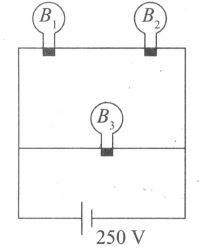Q.
A $100\,W$ bulb $B_{1}$ and two $60\,W$ bulbs $B_{2}$ and $B_{3}$ are connected to a $250\,V$ source as shown in the figure. Now $W_{1},W_{2}$ and $W_{3}$ are the output powers of the bulbs $B_{1},B_{2}$ and $B_{3}$ respectively. Then

NTA AbhyasNTA Abhyas 2022
Solution: